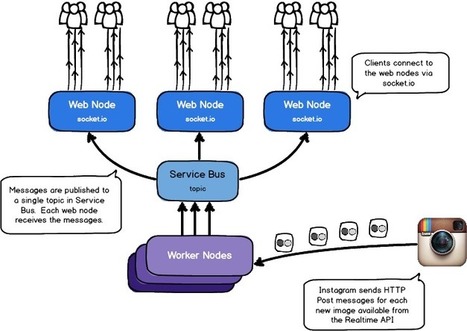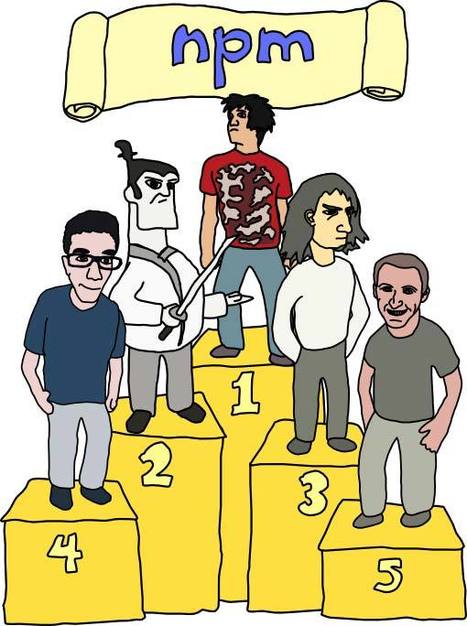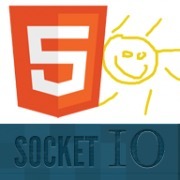 Your new post is loading...
 Your new post is loading...
Wazstagram is an experiment with node.js on Windows Azure and the Instagram Realtime API. It uses node.js, socket.io, and service bus to create a scalable window into Instagram traffic across multiple cities.
PHP knows how to group classes under a common namespace, and to create redistributable packages using PEAR. Node.js is also very good at organizing code into modular and reusable sets, but there are key differences.
I recently started working on a few Node.js applications. Coming most recently from PHP (and Drupal in particular), I found the transition to Node.js to be surprisingly easy. Pleasurable, in fact. But I had to learn to think differently about a few things.
Below I list the five things I think every PHP developer should know about Node.js : 1. Node.js Is Built On Chrome's JavaScript Engine 2. Node.js Isn't (Just) A Web Server or Platform 3. Node.js Is Object-Oriented (In That Weird JavaScript Way) 4. Evented I/O? 5. Package Management is a Must!
This project provides a set of Node.js packages that make it easy to access the Windows Azure storage and queue services. --Features-- -Tables : create and delete tablescreate, query, insert, update, merge, and delete entities - Blobs : create, list, and delete containers, work with container metadata and permissions, list blobs in containercreate block and page blobs (from a stream, a file, or a string), work with blob blocks and pages, delete blobswork with blob properties, metadata, leases, snapshot a blob - Queues : create, list, and delete queues, and work with queue metadatacreate, get, peek, update, delete messages
In this tutorial, you will learn how to setup a complete Node.js development environment, including NPM (the Node Package Manager) and Cloud9 IDE to edit, run, and debug Node programs. The following installation instructions have been sucessfully tested on Debian 6.0 “Squeeze” and on Ubuntu 11.10 “Oneiric Ocelot”, but they should also work properly on previous versions as well.
We will install everything in the user’s home directory : this way, there is no need for any root access to the machine (provided the required packages are, of course, already installed), and each user can manage its own version of Node.
Developers, time to geek out. Yahoo! has been working behind the scenes for the past several months on an exciting new technology that we think will deeply impact the web developer community. We call it “Cocktails” and it’s the technology powering Livestand, which we launched today at Product Runway. “Cocktails” is a mix of HTML5, Node.JS, CSS3, JavaScript and a lot of ingenious, creative mind-bending tricks from Yahoo!’s engineers. Today, we are announcing two Cocktails: Yahoo!’s Mojito, an environment-agnostic JavaScript web application framework, and Yahoo! Manhattan, a hosted platform for Mojito-based applications.
The HTTP version of the app worked, but the commandline version did not. What went wrong? It was hard to say. The application simply hung, unresponsive. Try/catch and event handlers didn't find anything wrong, and my typical console.log()approach wasn't cutting it, either. I need to fire up Node.js's command line debugger. This is a short tutorial explaining how to use the debugger that comes built-in to Node.js. It explains how to use the command line debugger to set breakpoints , step through the code, and analyze the debugging output. By the time you're done reading, you should be able to quickly debug your own code.
Talk about node.js and WebSockets...
Cube is an open-source system for visualizing time series data, built on MongoDB, Node and D3. If you send Cube timestamped events (with optional structured data), you can easily build realtime visualizations of aggregate metrics for internal dashboards. Cube speaks WebSockets for low-latency, asynchronous input and output: new events are streamed in, and requested metrics are streamed out as they are computed. (You can also POST events to Cube, if that’s your thing, and collectd integration is included!) Metrics are cached in capped collections, and simple reductions such as sum and max use pyramidal aggregation to improve performance. Visualizations are generated client-side and assembled into dashboards with a few mouse clicks.
We're huge open-source fans at Browserling and we have open-sourced 90 node.js modules. More modules coming as we keep developing Browserling and Testling!
Introducing osmus, a multiplayer HTML5 game written with web sockets, canvas and a game engine that runs shared code on the client and server.
Kiran Prasad (running mobile development at LinkedIn), talks about their approach to building hybrid applications: - Reuse of HTML5 code across all three applications (mobile web, iOS and Android) - Client framework : Backbone + Zepto + Underscore + Handlebars + Stylus - Server-side : node + socket.io (WebSockets) + redis + mongo On the specific node.js topic, see : http://venturebeat.com/2011/08/16/linkedin-node/
NodObjC exposes the Objective-C runtime to NodeJS in a high-level, easy to use fashion. It uses the BridgeSupport files to dynamically generate an API from an Objective-C "Framework" at runtime, and uses node-ffi to dynamically interact with Objective-C's runtime.
Essentially, NodObjC is similar in nature to the other popular Objective-C scripting bridges:
- JSCocoa
- PyObjC
- CocoaRuby
So you can write Objective-C based applications entirely with Node and JavaScript! Eventually even iOS native apps as well! So what are you waiting for? Get to coding!
|
Scalability. Big Data. Real Time. These are some of the challenges that a web application has to face in the modern World Wide Web. This is where Node.js and its non-blocking I/O model comes into play. This article will introduce you to one of Node’s most powerful APIs for data intensive computing, streams.
For a PHP developer, asynchronicity is the most puzzling aspect of the Node.js runtime. It's simply a new way to write programs. And once you pass the first learning steps, event-driven programming opens a world of possibilities PHP programmers would never dream of. I'll try to explain you how it works, but first, let's talk about pasta.
Cube is an open-source system for visualizing time series data, built on MongoDB, Node and D3. If you send Cube timestamped events (with optional structured data), you can easily build realtime visualizations of aggregate metrics for internal dashboards.
Cube speaks WebSockets for low-latency, asynchronous input and output: new events are streamed in, and requested metrics are streamed out as they are computed. (You can also POST events to Cube, if that’s your thing, and collectd integration is included!) Metrics are cached in capped collections, and simple reductions such as sum and max use pyramidal aggregation to improve performance. Visualizations are generated client-side and assembled into dashboards with a few mouse clicks.
This past weekend I had the pleasure of putting on workshop at the Mozilla Festival in London. During the workshop I explained exactly how to take a single player HTML5 game and turn it into a multiplayer one using Node.js and WebSockets.
DNode is a remote method invocation protocol originally written for Node.js, as the name probably tells. But as the protocol itself is quite simple, just sending newline-terminated JSON packets over TCP connections, implementations have started popping up in other languages. You can talk DNode in Ruby, Perl, Python, Java, and now PHP.
With DNode you can expose Node.js functions to be available on PHP, and PHP class methods to be available on Node.
Like most Node.js functionality, DNode works asynchronously. So instead of waiting for return values you supply a callback function that will be called when the method completes.
Web sockets and Canvas are two really cool features that are currently being implemented into browsers. This tutorial will give you a short rundown of how they both work as well as create a realtime drawing canvas that is powered by Node.js and web sockets.
On Tuesday I did a presentation for the Pittsburgh JavaScript Developers Meetup group about using Node.js with NoSQL – or document based – databases. I chose MongoDB because it’s got great traction and there’s a Node module for it named Mongoose. Unfortunately, I was on vacation the week before the presentation, so I didn’t get to cover absolutely everything that I wanted to, but I was able to show some great highlights of what can be done with Mongoose. When I first started to look in to it, I was immediately attracted to its syntax and API being very JavaScript friendly. First things first, though. You can install Mongoose easily by using npm – npm install mongoose.
Created by Ryan Dahl in 2009, Node.js is a relatively new technology which has gained a lot of popularity among Web developers recently. However, not everyone knows what it really is. Node.js is essentially a server-side JavaScript environment that uses an asynchronous event-driven model. What this means is simple: it’s an environment which is intended for writing scalable, high performance network applications. It’s like Ruby’s Event Machine or Python’s Twisted, but it takes the event model a bit further—it presents the event loop as a language construct instead of as a library. And that’s not all: what’s really great about Node.js is the thousands of modules available for any purpose, as well as the vibrant community behind this young project. In this round-up, you will find the most useful resources for Node.js, from handy tools to detailed tutorials, not to mention in-depth articles and resources on this promising technology.
This past week I undertook a pretty cool project as the Intern here at Cykod. We were wondering how easily a smart phone –specifically using its gyroscopes and accelerometers– could be used as a controller for a multi-player game on a larger screen. With a bit of Node.js and HTML5 magic, it turned out to be pretty simple. Concept : We want to use a desktop (laptop, iPad, etc. something with a bigger screen that multiple players can easily look at) connection to act as the common game space. Once that screen is initialized, each player connects to a specific URL in their phone browser that links them to that game instance. We'll follow this basic outline: - Register new connections to the server and decide if it is a room or mobile user: - Create a new room, - Or add the connection to an existing room - Constantly poll the mobile device for orientation data - Use said data to update the HTML5 Canvas game - Handle dropped connections appropriately Result : The proof-of-concept full game is up at http://bit.ly/G4LSpaceWords
Superfeedr released a Node XMPP Server. “Since astro had been doing an amazing work with his node-xmpp library to build Client, Components and even Server to server modules, the logical next step was to try to build a Client to Server module so that we could have a full blown server. That’s what we worked on the past couple days, and it’s now on Github! Joyent’s Mark Cavage released LDAP.js. “ldapjs is a pure JavaScript, from-scratch framework for implementing LDAP clients and servers in Node.js. It is intended for developers used to interacting with HTTP services in node and express. Microsoft’s Tomasz Janczuk released iisnode “The iisnode project provides a native IIS 7.x module that allows hosting of node.js applications in IIS.
NodePing’s server monitoring service was built from the front-end webapp to the backend SMTP requests, in 100% Node.js. For those who may not be familiar with it, Node.js is server-side javascript using Google’s famed V8 engine. It’s that engine that makes your Chrome browser so fast at javascript processing and NodePing so efficient at service monitoring. Arguably, Node.js’ most interesting feature is the performance of its evented, asynchronous, non-blocking IO. In javascript fashion, the vast majority of IO functions use callbacks to handle the ‘results’. This allows the logic of NodePing to branch out in several directions without IO processes blocking others. This handling works when talking to databases, reading and writing files, and talking to other machines via network protocols.
SocketStream is a new full stack web framework built around the Single-page Application paradigm. It embraces websockets, in-memory datastores (Redis), and client-side rendering to provide an ultra-responsive experience that will amaze your users.
Features (extract) :
- True bi-directional communication using websockets (or flashsockets)
- Works great on iPads and iPhones using Mobile Safari (iOS 4.2 and above), even over 3G
- In-built User model with modular authentication. Automatically keeps track of users online.
|
 Your new post is loading...
Your new post is loading...
 Your new post is loading...
Your new post is loading...



























